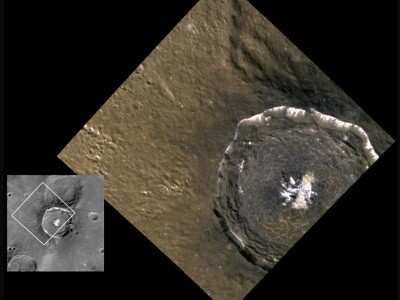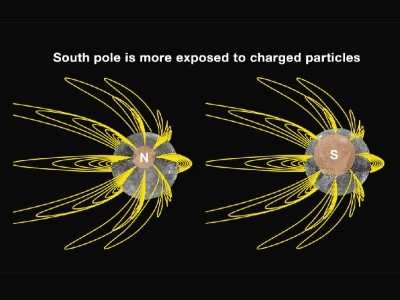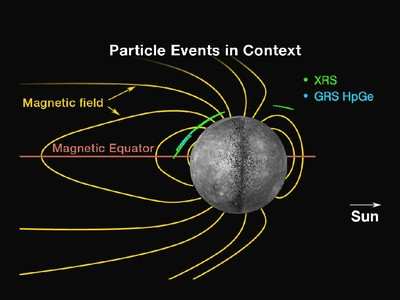NASA Says Tens Of Thousands Of Hi-Res Images Being Transmitted
Back To Earth
After nearly three months in orbit about Mercury, MESSENGER's
payload is providing a wealth of new information about the planet
closest to the Sun, as well as a few surprises.

The spacecraft entered orbit around Mercury on March 18, 2011
UTC, becoming the first spacecraft ever to do so. Tens of thousands
of images of major features on the planet — previously seen
only at comparatively low resolution — are now available in
sharp focus. Measurements of the chemical composition of Mercury's
surface are providing important clues to the origin of the planet
and its geological history. Maps of the planet's topography and
magnetic field are revealing new clues to Mercury's interior
dynamical processes. And scientists now know that bursts of
energetic particles in Mercury's magnetosphere are a continuing
product of the interaction of Mercury's magnetic field with the
solar wind.
This week, MESSENGER completed is first perihelion passage from
orbit, its first superior solar conjunction from orbit, and its
first orbit-correction maneuver. "Those milestones provide
important context to the continuing feast of new observations that
MESSENGER has been sending home on nearly a daily basis,”
offers MESSENGER Principal investigator Sean Solomon of the
Carnegie Institution of Washington.

NASA MESSENGER Image
Among the fascinating features seen in MESSENGER flyby images of
Mercury were bright, patchy deposits on some crater floors. Without
high-resolution images to obtain a closer look, these features
remained a curiosity. New targeted Mercury Dual Imaging System
images at up to 10 meters per pixel reveal these patchy deposits to
be clusters of rimless, irregular pits varying in size from
hundreds of meters to several kilometers. These pits are often
surrounded by diffuse halos of higher-reflectance material, and
they are found associated with central peaks, peak rings, and rims
of craters.
"The etched appearance of these landforms is unlike anything
we've seen before on Mercury or the Moon,” says Brett Denevi,
a staff scientist at the Johns Hopkins University Applied Physics
Laboratory (APL) in Laurel, Md., and a member of the MESSENGER
imaging team. "We are still debating their origin, but they appear
to have a relatively young age and may suggest a more abundant than
expected volatile component in Mercury's crust.”

Spectometer Data
The X-ray Spectrometer (XRS) — one of two instruments on
MESSENGER designed to measure the abundances of many key elements
on Mercury — has made several important discoveries since the
orbital mission began. The magnesium/silicon, aluminum/silicon, and
calcium/silicon ratios averaged over large areas of the planet's
surface show that, unlike the surface of the Moon, Mercury's
surface is not dominated by feldspar-rich rocks.
XRS observations have also revealed substantial amounts of
sulfur at Mercury's surface, lending support to prior suggestions
from ground-based telescopic spectral observations that sulfide
minerals are present. This discovery suggests that the original
building blocks from which Mercury was assembled may have been less
oxidized than those that formed the other terrestrial planets, and
it has potentially important implications for understanding the
nature of volcanism on Mercury.
MESSENGER's Mercury Laser Altimeter has been systematically
mapping the topography of Mercury's northern hemisphere. After more
than two million laser-ranging observations, the planet's
large-scale shape and profiles of geological features are both
being revealed in high detail. The north polar region of Mercury,
for instance, is a broad area of low elevations. The overall range
in topographic heights seen to date exceeds 9 kilometers.

Magnetic Field Mapping
Two decades ago, Earth-based radar images showed that around
both Mercury's north and south poles are deposits characterized by
high radar backscatter. These polar deposits are thought to consist
of water ice and perhaps other ices preserved on the cold,
permanently shadowed floors of high-latitude impact craters.
MESSENGER's altimeter is testing this idea by measuring the floor
depths of craters near Mercury's north pole. To date, the depths of
craters hosting polar deposits are consistent with the idea that
those deposits occupy areas in permanent shadow.
One of the major discoveries made by Mariner 10 during the first
of its three flybys of Mercury in 1974 were bursts of energetic
particles in Mercury's Earth-like magnetosphere. Four bursts of
particles were observed on that flyby, so it was puzzling that no
such strong events were detected by MESSENGER during any of its
three flybys of the planet in 2008 and 2009. With MESSENGER now in
near-polar orbit about Mercury, energetic events are being seen
almost like clockwork.

"We are assembling a global overview of the nature and workings
of Mercury for the first time,” adds Solomon, "and many of
our earlier ideas are being cast aside as new observations lead to
new insights. Our primary mission has another three Mercury years
to run, and we can expect more surprises as our solar system's
innermost planet reveals its long-held secrets."
 Airbus Racer Helicopter Demonstrator First Flight Part of Clean Sky 2 Initiative
Airbus Racer Helicopter Demonstrator First Flight Part of Clean Sky 2 Initiative Diamond's Electric DA40 Finds Fans at Dübendorf
Diamond's Electric DA40 Finds Fans at Dübendorf ANN's Daily Aero-Term (04.23.24): Line Up And Wait (LUAW)
ANN's Daily Aero-Term (04.23.24): Line Up And Wait (LUAW) NTSB Final Report: Extra Flugzeugbau GMBH EA300/L
NTSB Final Report: Extra Flugzeugbau GMBH EA300/L Classic Aero-TV: 'Never Give Up' - Advice From Two of FedEx's Female Captains
Classic Aero-TV: 'Never Give Up' - Advice From Two of FedEx's Female Captains







